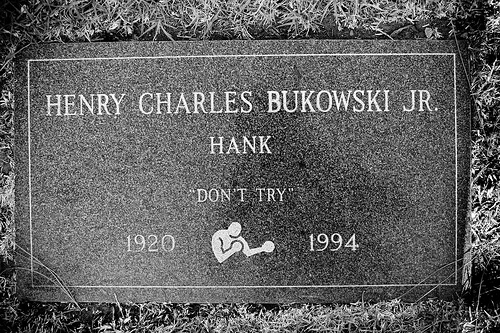
This post originally appeared on the Crew blog.
Despite spending the last half decade writing for a living, I still have a serious issue with getting down to the ugly, dirty business of putting words on paper.
I sit and stare at the blank page while every blink of the cursor reminds me that time is definitely not on my side and that I need to just get to it.
Despite all of the lessons you can read online about how to best put together a blog post or any other piece of writing, the core issue remains: how do you just get to it when your deadline is looming?
Write ugly. Write fast. Make mistakes
We’re a small team at Crew and I rely on pitches from our contributing writers to keep up with my publishing schedule. While I love the variety that working with freelancers brings to our blog, there’s always a bit of uncertainty when working with people outside of your company. Contributions dry up and people can move on or become uninterested.
I learned early on to keep a running idea list that I can easily pull from whenever I need to put together an article quickly. My idea gathering process is one that most writers are familiar with: Feel the strike of inspiration. Jot down the idea in a Notes doc. Summarize a few key points. And then forget about it entirely.
Inevitably when I came back to my list ready to write that initial streak of interest had faded.
The way we feel about things disappears with time and trying to write without that initial spark just makes it too easy for our inner critic to come out and suffocate us with self-doubt.
Sometimes we need a way to just get past that and kickstart our writing.
In her 1934 book Becoming a Writer, Dorothea Brande suggests a method of writing as quickly as possible for 30 minutes as soon as you wake up. The idea is that you do the dirty work and get your ideas, key points, and raw materials down, so that you can come back later and polish.
Nowadays, we refer to this as ‘free writing’ and it’s been used by fiction and non-fiction writers alike to clear their heads and jump start the writing process.
It’s an incredible tool and one that I use on a regular basis.
While there’s no set rules of how to free write, here’s the basics if you want to try it out:
1) Just start writing (and don’t stop)
You can think of free writing as forcing yourself into a state of flow where you write as quickly as the thoughts come into your head. One of Brande’s key points in her book was that the pencil should never leave the page during your session.
This means silencing your inner critic and ignoring the typos, terrible grammar, sentences that make no sense, and punctuation that would normally make you cringe (especially if, like me, you have OSED—Obsessive Self Editing Disorder).
Here’s a look at the above paragraph from my initial draft:
Pretty bad, eh?
If you’re worried about not being able to write enough, remember that the point is quantity over quality. Just get those words down there. In the best-case scenario you’ll be sitting down to a free writing session with the research still somewhat fresh in your mind. But if not, you can always skim the articles and notes you’ve included in your idea list before you go at it.
2) Set out a block of time to work
The best way to force yourself into this free writing flow state is to set a specific amount of time you’re going to work for. That way, instead of being tied to your own thoughts you’re working against the clock. It’s a lot easier to spill out your ideas and force yourself to continue writing when you know you only have 5-10 minutes to work.
What I’ve done in the past is choose five topics from my idea list and set a timer for 10 minutes to work on each (taking only a short break in between). At the end of an hour I’ve got five nearly-completed blog posts ready to go.
3) Write how you think
The way we think and talk has a natural flow to it that so many people find difficult to capture in writing. Whether it’s the rich and violently descriptive nature of Cormac McCarthy, or the bare-bones straight-to-the-point narratives of Hemingway, every writer wants to find their ‘voice’.
Free writing is an incredible way to find your personal style. While you write you don’t have time to think about how you’re phrasing things or the style you want to use. Hell, you barely have time to think about what word is going to come next before you’re past it.
This is scary. I won’t deny it. But it is also an easy way to force yourself to write naturally. Instead of getting caught up in how cringe-worthy some of your sentences are, let them flow out of you without judgment. When you go back to edit, look at how you put things down in the first place. Hidden among the run-on sentences and comma splices will be some nuggets of writerly gold.
4) Follow your thoughts
On Charles Bukowski’s grave there’s an engraving of a boxer below the short phrase ‘don’t try’. This is a perfect metaphor for what should come to mind when you think about free writing.
To me, ‘don’t try’ means letting go of your preconceived ideas about what you’re writing. If you go off topic, go with it. Chase that tangential dragon. I’ve had articles pivot drastically during a free writing session and turn into something much more interesting than what I’d originally planned.
One other thing that will also happen (whether you want it to or not) is that you’ll say the same things multiple times. And that’s OK. Even if you edit out half or more of what you put down (and you should) you’ll end up with 4 or 5 different approaches to the same issue.
Through free writing you’ve effectively A/B tested your topic, creating variations that you can then look at and decide which one works best.
5) Find your happy place
This should probably be at the top of the list, but one last thing I’ve found to help me in this process is to put myself in as close to a meditative state as possible. For me that means headphones in; Nils Frahm’s Spacesalbum on Spotify; and a coffee and a glass of water beside me (or a beer depending on what mood I’m in (hey! don’t judge)).
For you, your happy place might be somewhere completely different, like among the buzz of a coffee shop or nestled in the silence of a library.
Recognize where you focus and work best and use that to your advantage.
How I wrote 20 blog posts in 2 days
This all sounds good in theory doesn’t it? Clear out that idea list that’s been growing out of control, give yourself a backlog of content to work on so you have time for other tasks, and all the while begin to find and define your personal tone and writing style.
But how does it work in practice?
(I want to preface this by saying that the men in my family have a problem: we’re martyrs. When there is a problem, we’ll gladly climb up onto the cross rather than pass the discomfort along to others. So when I came to a slump in our publishing schedule and saw the empty days on our calendar I decided I needed to take action. My example is extreme and free writing works just as well whether you’re using it to write 1 or 100 posts.)
The first step was to go through my initial idea list and pick out articles I wanted to work on. I settled on 20 of them.
I split these into four groups of five, trying to put similar ideas together so I could stay in the same state of mind for the allotted time.
Then I got myself into my optimal free writing state and started writing.
One hour, five articles. Half an hour break to clear my head and then another 5.
The next day I did the same thing and after four strenuous free writing sessions over five hours I had enough content filled up to let me breathe a sigh of relief.
The takeaway
This wasn’t easy.
When I first started writing my brain kept telling me to move onto something else—to stop and take on some easy job like checking e-mails or replying to Tweets. But at the end of each session I realized that I had almost a month of content that would only need an hour or two of editing and further research to be publishable.
I also found that free writing a large group of topics like this is an amazing way to weed out bad ideas. When you’re struggling to write for 5 minutes on one topic it’s a safe bet that you should drop it from the list and move onto the next one.
At the end of my two writing sessions I filled out 16 of my 20 topics (four got tossed) and had written 11638 words, averaging 727 words per article. We aim for posts that are around 1500-2000 words, so each one isn’t completely done but there’s now a structure in place and enough solid points and takeaways to be easily published after another short research and editing session.
As a ‘writer’ it’s sad that the thing I find hardest is getting down to the nitty gritty of writing.
We all want to see a finished product and not have to go through the work, but success is just a byproduct of showing up day after day.
As Ernest Hemingway so eloquently put it:
“I write one page of masterpiece to ninety-one pages of shit.”
It’s good to remember that free writing isn’t just for blog editors or novelists.
It’s an amazing way to get ideas down quickly and to test how far they can go. Once you start putting down ideas and thoughts this way you’ll quickly realize if there’s enough to go on or if it’s something you should abandon. Instead of spending days on it, you’ve only spent ten minutes.
Think of your free writing as the MVP of your content—it’s the bare bones that you still need to dress up before you can take it to the dance.
Lastly (because I know you’re going to ask): did I free write this article? You bet I did.
Image credits: Doug Robichaud, Lummox Press, Shutterstock
Read Next: Demystifying the muse: 5 creativity myths you need to stop believing
Get the TNW newsletter
Get the most important tech news in your inbox each week.








